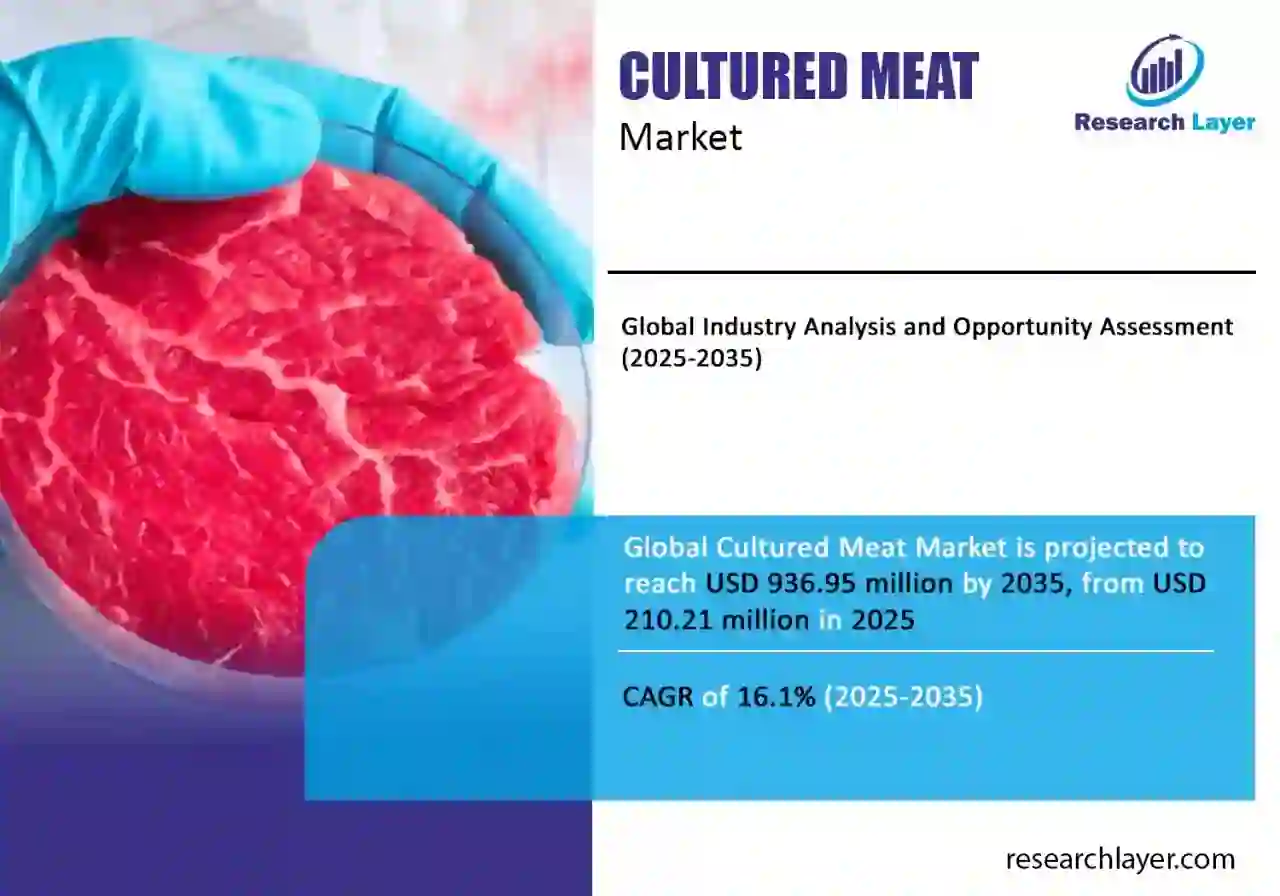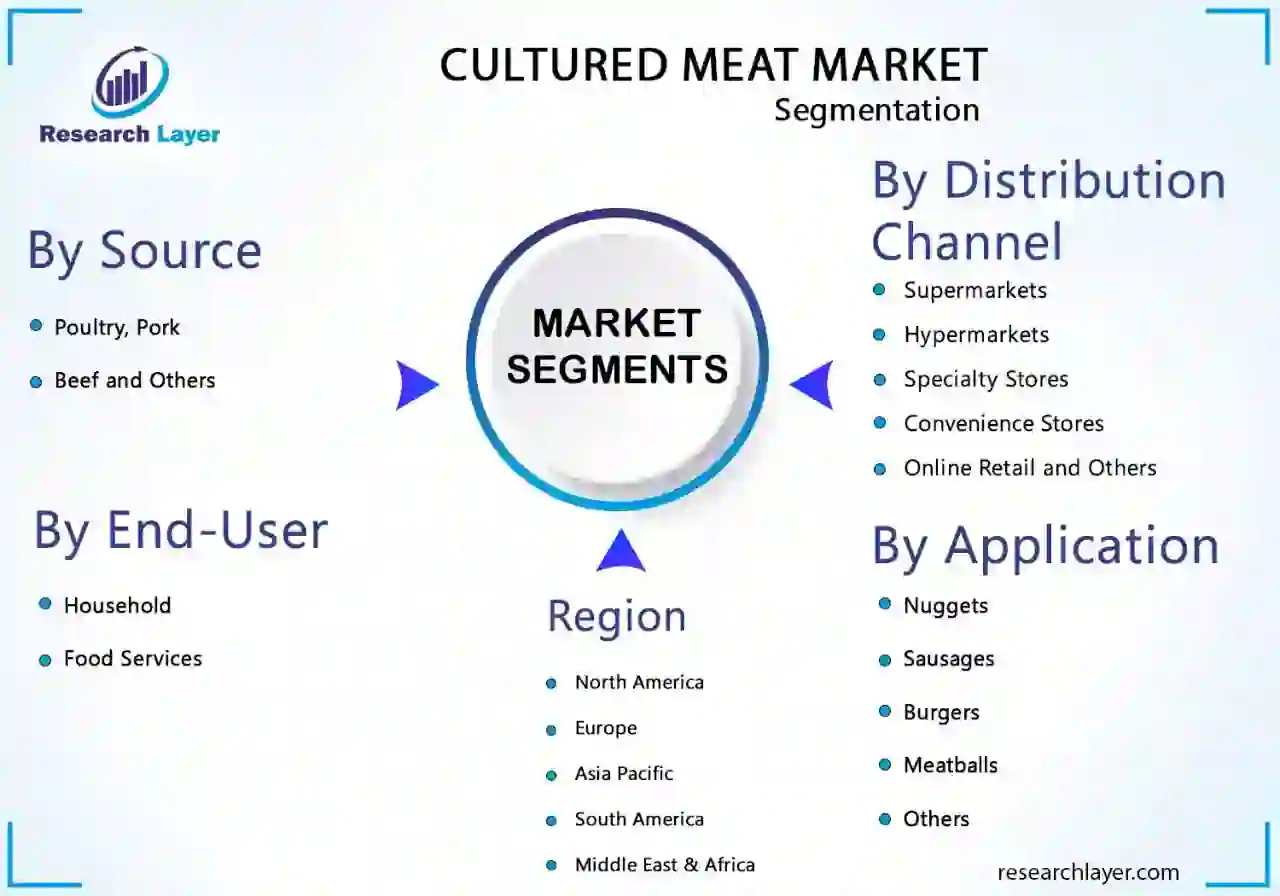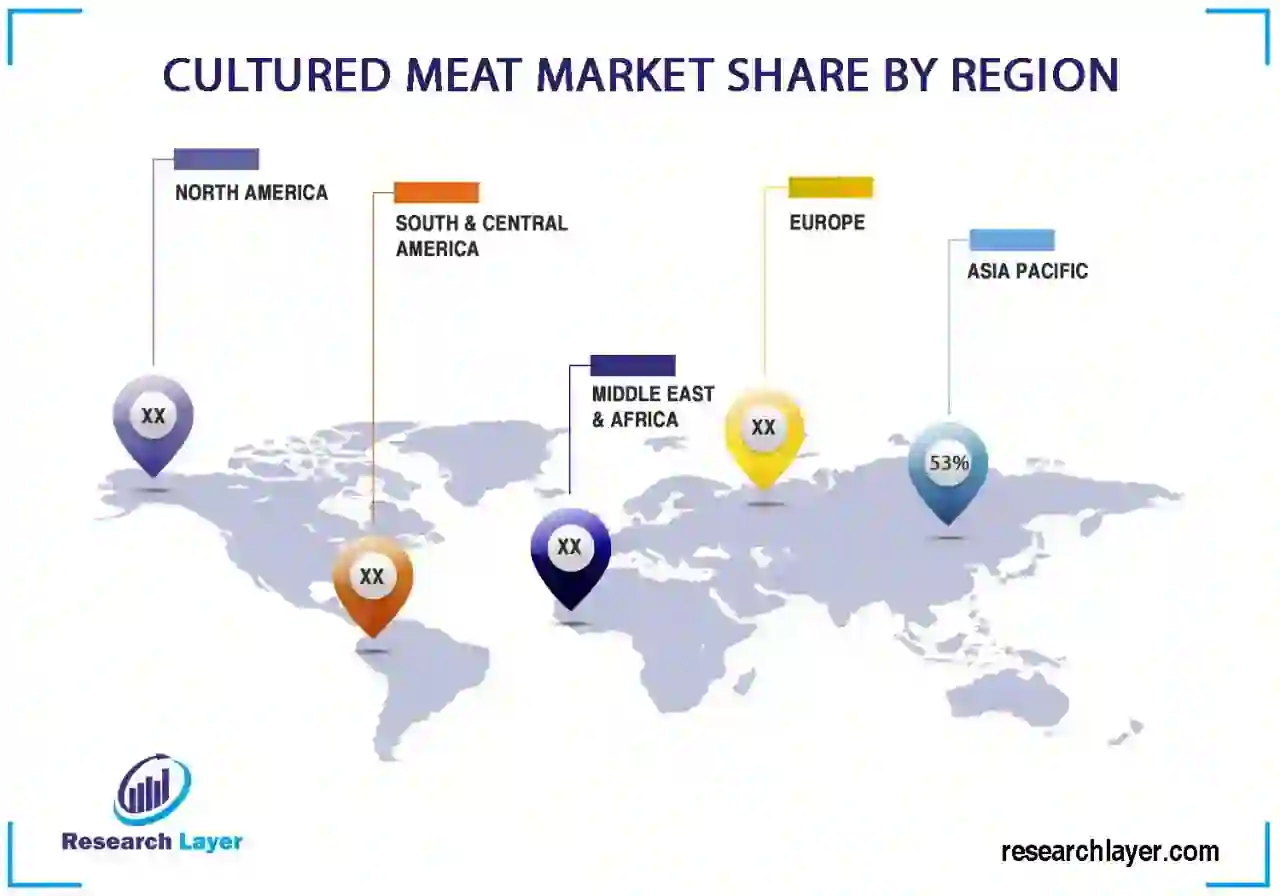 +1 915 229 3004 (U.S.) |
+1 915 229 3004 (U.S.) |  +44 7452 242832 (U.K.)
+44 7452 242832 (U.K.)
 +1 915 229 3004 (U.S.) |
+1 915 229 3004 (U.S.) |  +44 7452 242832 (U.K.)
+44 7452 242832 (U.K.)

The global cultured meat market is projected to reach USD 936.95 million by 2035, from USD 210.21 million in 2025, and is anticipated to register a CAGR of 16.1% between 2025 and 2035.


Download Free Report Sample to learn more about this report.
Instead of on the farm, a lab may hold the secret to food in the future. Many businesses worldwide have started producing what they refer to as cultured meat, which is sausage, fillet, or hamburger created in a lab from animal cells rather than being made from animals that have been killed. At least three businesses — Mosa Meat, Modern Meadow, and SuperMeat — intend to develop cultured meat in the next years, even though it is not yet commercially available. Since livestock production is responsible for nearly one-fifth of all human-caused greenhouse gas emissions and about 30% of the planet's surface is used for grazing animals or growing feed crops, proponents of this novel type of meat claim that if it can be perfected, it could help with issues like world hunger and climate change.
Since cultured meat has yet to be made available for purchase, the market won't see any adverse income effects. In the next years, it is anticipated that this will postpone the launch of the new product. The majority of research institutions and institutes that produce cultured meat have discovered that their research grants and financing have taken a big hit as a result of the economies' slowdown and dried-up funding. Additionally, because of the pandemic scenario, governments and private groups have transferred financing to other important projects like providing patients with appropriate care and resolving ongoing issues. In contrast, private organizations have begun cutting back on funding to sustain financial flow.


Download Free Report Sample to learn more about this report.
On the basis of source, the global market is segmented into poultry, pork, beef, and others.
Poultry source dominated the segment. A steady supply of poultry meat at affordable rates is the goal of poultry meat production. With the poultry sector now earning 20 billion USD, the poultry industry has been expanding over the past few decades (Gbiti, nd). The output of other poultry species, such as ducks, geese, and quails, which are raised primarily for their meat or eggs, is also affected by this trend. However, because of the high stocking density, poultry meat production produces a lot of animal waste. Along with environmental issues, this can result in risks to the public's health from harmful microorganisms that cause water pollution.
On the basis of users, the market is segmented into household and food service.
Food service sub segment dominated the segment for cultured meat market. Due to the significant risk of purchasing highly valued food and the low customer acceptance of cultured meat, food services, including fast food chains, restaurants, hotels, and cafes, are anticipated to be late adopters of the technology. They are, therefore more likely to start out as the cultured meat's slow adopters and gradually start supplying them in response to demand.
Increasing Concerns about Environment and Rising Demand for Meat
As more people explore alternatives to raising and killing animals for food, a food revolution will soon be upon us. Entrepreneurs are attempting to reimagine farming in academic labs and Silicon Valley start-ups, focusing on crops and cattle. According to food experts, lab-grown beef may be available in supermarkets in five years, revolutionizing global farming techniques. The world's desire for meat has increased fourfold in the past 50 years; it has doubled since 1980 and is predicted to do so once more by 2050. According to a recent World Resources Institute research, by then, we will consume two-thirds more animal protein than we did at the turn of the millennium (WRI). In order to provide animal feed and provide grazing land, nine billion hectares of land will be farmed annually throughout the world. One-third of the water on the planet will be needed for it, and the UN estimates that it may up the planet's greenhouse gas emissions by as much as 80%.
Willem Van Eelen, an Amsterdam-based researcher, hopes to avert a crisis with a farming revolution without raising animals to prevent a crisis. Eelen, a vegan who prefers lab-grown beef to veggies formed into patties under the vegan banner, declares, "This is not an option." "Today's meat manufacturing has a terrible impact on the environment."
He could have a point—nearly a billion people still go without food every day, even though over half of all crops cultivated globally are used as animal feed. The WRI estimates that livestock uses 30% of the planet's acreage more than any other activity. Furthermore, it produces one-fifth of all greenhouse gases produced by human activity. The Carbon Trust believes that farming and food production consume up to 60% of freshwater in the UK alone.
Safer Than Traditional Meat
Antibiotic-resistant bacteria are stored in the bodies of livestock animals. According to the WHO (World Health Organization), infections brought on by multi-resistant bacteria like "Staphylococcus aureus," and "Campylobacter," (some are zoonotic) can lead to 100,000 deaths in Europe every year. Since livestock farmers frequently use antibiotics to treat illnesses in their animals, these bacteria have evolved resistance to them.
On the other side, cultured beef has no living cells; therefore, consuming it carries no risk of exposing consumers to animal viruses or antibiotic resistance genes. It has also been proved that the cell culturing system is free from these types of dangers, and infections can be excluded due to this closed cell culture method.
Furthermore, compared to existing meat manufacturing, which makes extensive use of animal waste, the method of this invention's method for cultivating stem cells or muscle cells in a culture system is significantly safer. Due to the severe hazards to food safety associated with conventional meat production as well as the prevalence of harmful bacteria and other pollutants, Due to the removal of these dangers, the use of cell culture as described herein significantly improves food safety.
Another theory contends that consuming contaminated meat items containing infectious prions can cause people to contract bovine spongiform encephalopathy (BSE) or mad cow disease. However, numerous investigations have demonstrated that cultured meat made from healthy animals' muscles or stem cells is free of infectious prions. As a result, the cultured meat presented here offers a secure substitute for the way meat is now produced.
Cultured Meat Market Restraints:Lack of Public Awareness and High-Cost May Hinder the Market Growth to Some Extent
Producing cultured beef requires the use of bioreactors and other machinery in a factory setting that is probably unfamiliar to customers. Due to this, it could be required to inform consumers about the manufacturing process for these products and the safety precautions that were implemented. Customers must have faith that these food products are made ethically and sustainably. Experience suggests that when people learn about problems with livestock farming's treatment of animals, their willingness to eat meat substantially declines. As a result, cultured meat also has to consider animal welfare.
It is unclear whether or not customers will accept cultured beef, and even if they do, the question of whether or not they will purchase it frequently still remains. Cultures' perspectives on cultured meat are probably going to differ from one another. However, there are currently businesses selling items created from animal cells in various nations, primarily for medical uses, including Germany, Austria, Switzerland, and Sweden. Since these items don't closely resemble conventional meat as food products would according to this invention, the latter may be easier for customers to accept.
However, compared to traditional beef, cultured meat is now highly expensive. As a result, it appears unlikely that it will develop into a viable alternative, at least in the near term. According to present invention, this problem can be overcome by improving both cell culturing conditions and product processing procedures. Additionally, it is anticipated that the price of cultured meat will drop in line with rising demand and the realisation of economies of scale.
In conclusion, even though there are still obstacles to be overcome before cultured meat can become a widely accepted food product, it is very likely that such products will find a market once they have been developed into an aesthetically pleasing form for consumers that does not involve any genetic modification or increased use of antibiotics.


Download Free Report Sample to learn more about this report.
Asia Pacific has grabbed a significant share of the market during the prediction period.
The media frequently refers to cultured or "clean" meat as "the future of food" and as a potential means of reducing global hunger. Those who favor clean meat may be the solution to issues like overfishing, animal abuse, and land degradation brought on by animals like cattle, pigs, and chickens. But, according to reports, clean meat doesn't have the same problems with disease contamination as typical animal products.
The Asia-Pacific region is anticipated to emerge as the leading consumer of cultured meat industry by 2040, with China forecasted to have a share of 53 percent in the cultured meat market. According to projections, shares for Japan and South Korea will be 23% and 19%, respectively. Compared to the US or Europe, China now has a more developed sector for cultured animal products, which presents substantial prospects for start-ups like Memphis Meats, which garnered four million dollars in funding from organizations like DFJ and Bill Gates. The first cultured meat business in Australia was started in 2015 by businessman and Olympian swimmer Spencer Bowman. Since then, his business has been devoted to developing synthetic meats that both humans and animals can consume.
Some of the major key players operating in the cultured meat market are Upside Foods, Mosa Meat, Cubiq Foods, SuperMeat, Eat Just, Inc., Integriculture, Fork & Goode, Finless Foods Inc, Avant Meats Company Limited, Shiok Meats, Future Meat Technologies Ltd, Mission Barns, Appleton Meats, and Biofood Systems.
This report categorizes the Cultured Meat market as follows:
As per Research Layer predicted growth rate of Global Cultured Meat market is 16.1% by forecasted period.
As per Research Layer Asia Pacific has grabbed a significant share of the market during the prediction period.
The Segments Coverd in the global Cultured Meat Market are Source, End-User, Application, Distribution Channel and Regional.
Key Companies of the global Cultured Meat Market are Upside Foods, Mosa Meat, Cubiq Foods, SuperMeat, Eat Just, Inc., Integriculture, Fork & Goode, Finless Foods Inc, Avant Meats Company Limited, Shiok Meats, Future Meat Technologies Ltd, Mission Barns, Appleton Meats, and Biofood Systems.
The global Cultured Meat Market was valued at USD 210.21 million in 2025, and it is estimated to reach USD 936.95 million by 2035.


Report Code :
RL6520
Published on :
Nov 2022
Request a Free Sample Report